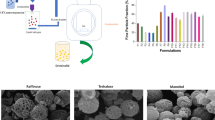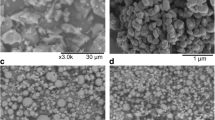Abstract
Novel advanced spray-dried inhalable trehalose microparticulate/nanoparticulate powders with low water content were successfully produced by organic solution advanced spray drying from dilute solution under various spray-drying conditions. Laser diffraction was used to determine the volumetric particle size and size distribution. Particle morphology and surface morphology was imaged and examined by scanning electron microscopy. Hot-stage microscopy was used to visualize the presence/absence of birefringency before and following particle engineering design pharmaceutical processing, as well as phase transition behavior upon heating. Water content in the solid state was quantified by Karl Fisher (KF) coulometric titration. Solid-state phase transitions and degree of molecular order were examined by differential scanning calorimetry (DSC) and powder X-ray diffraction, respectively. Scanning electron microscopy showed a correlation between particle morphology, surface morphology, and spray drying pump rate. All advanced spray-dried microparticulate/nanoparticulate trehalose powders were in the respirable size range and exhibited a unimodal distribution. All spray-dried powders had very low water content, as quantified by KF. The absence of crystallinity in spray-dried particles was reflected in the powder X-ray diffractograms and confirmed by thermal analysis. DSC thermal analysis indicated that the novel advanced spray-dried inhalable trehalose microparticles and nanoparticles exhibited a clear glass transition (T g). This is consistent with the formation of the amorphous glassy state. Spray-dried amorphous glassy trehalose inhalable microparticles and nanoparticles exhibited vapor-induced (lyotropic) phase transitions with varying levels of relative humidity as measured by gravimetric vapor sorption at 25°C and 37°C.









Similar content being viewed by others
References
Hickey AJ, Mansour HM. Chapter 5: delivery of drugs by the pulmonary route. In: Florence AT, Siepmann J, editors. Modern Pharmaceutics. 5th ed. New York: Taylor and Francis, Inc.; 2009. p. 191–219.
Katzenstein AL, Myers JL. Idiopathic pulmonary fibrosis: clinical relevance of pathologic classification. Am J Respir Crit Care Med. 1998;157(4 Pt 1):1301–15.
Sethi S, Sethi R, Eschberger K, Lobbins P, Cai X, Grant BJ, et al. Airway bacterial concentrations and exacerbations of chronic obstructive pulmonary disease. Am J Respir Crit Care Med. 2007;176(4):356–61.
Sexauer WP, Fiel SB. Aerosolized antibiotics in cystic fibrosis. Semin Respir Crit Care Med. 2003;24(6):717–26.
Park CW, Hayes DJ, Mansour HM. Pulmonary inhalation aerosols for targeted antibiotics drug delivery. Invited paper. European Pharmaceutical Review. 2011;16(1):32–6.
Rhee YS, Mansour HM. Nanopharmaceuticals I: nanocarrier systems in drug delivery. Invited paper. International Journal of Nanotechnology Special Issue-Nanopharmaceuticals. 2011;8(1/2):84–114.
Wu X, Mansour HM. Nanopharmaceuticals II: application of nanoparticles and nanocarrier systems in pharmaceutics and nanomedicine. Invited Paper. International Journal of Nanotechnology Special Issue-Nanopharmaceuticals. 2011;8(1/2):115–45.
Mansour HM, Rhee YS, Wu X. Nanomedicine in pulmonary delivery. International Journal of Nanomedicine. 2009;4(December):299–319.
Patton JS, Byron PR. Inhaling medicines:delivering drugs to the body through the lungs. Nature Reviews Drug Discovery. 2007;6(1):67–74.
Hickey AJ, Mansour HM. Chapter 43: formulation challenges of powders for the delivery of small molecular weight molecules as aerosols. In: Rathbone MJ, Hadgraft J, Roberts MS, Lane M, editors. Modified-release drug delivery technology. 2nd ed. New York: Informa Healthcare; 2008. p. 573–602.
Zeng XM, Martin GP, Marriott C. Particulate Interactions in Dry Powder Formulations for Inhalation. ed., New York, NY: Taylor & Francis, Inc.; 2001. p. 225.
Hickey AJ, Mansour HM, Telko MJ, Xu Z, Smyth HD, Mulder T, et al. Physical characterization of component particles included in dry powder inhalers. I. Strategy review and static characteristics. J Pharm Sci. 2007;96(5):1282–301.
Xu Z, Mansour HM, Hickey AJ. Particle interactions in dry powder inhaler unit processes. Journal of Adhesion Science and Technology Special Issue on Adhesion Aspects in Pharmaceutical Sciences. 2011;25(4/5):451–82.
Xu Z, Mansour HM, Mulder T, McLean R, Langridge J, Hickey AJ. Heterogeneous particle deaggregation and its implication for therapeutic aerosol performance. J Pharm Sci. 2010;99(8):3442–61.
Chacon M, Molpeceres J, Berges L, Guzman M, Aberturas MR. Stability and freeze-drying of cyclosporine loaded poly(D, L lactide-glycolide) carriers. Eur J Pharm Sci. 1999;8(2):99–107.
Bosquillon C, Rouxhet PG, Ahimou F, Simon D, Culot C, Preat V, et al. Aerosolization properties, surface composition and physical state of spray-dried protein powders. J Control Release. 2004;99(3):357–67.
Abdelwahed W, Degobert G, Stainmesse S, Fessi H. Freeze-drying of nanoparticles: formulation, process and storage considerations. Adv Drug Deliv Rev. 2006;58(15):1688–713.
Lo YL, Tsai JC, Kuo JH. Liposomes and disaccharides as carriers in spray-dried powder formulations of superoxide dismutase. J Control Release. 2004;94(2–3):259–72.
Andya JD, Maa YF, Costantino HR, Nguyen PA, Dasovich N, Sweeney TD, et al. The effect of formulation excipients on protein stability and aerosol performance of spray-dried powders of a recombinant humanized anti-IgE monoclonal antibody. Pharm Res. 1999;16(3):350–8.
Garmise RJ, Staats HF, Hickey AJ. Novel dry powder preparations of whole inactivated influenza virus for nasal vaccination. AAPS PharmSciTech. 2007;8(4):article E81.
Crowe LM, Reid DS, Crowe JH. Is trehalose special for preserving dry biomaterials? Biophys J. 1996;71(4):2087–93.
Surana R, Pyne A, Suryanarayanan R. Effect of aging on the physical properties of amorphous trehalose. Pharm Research. 2004;21(5):867–74.
Fakes MG, Dali MV, Haby TA, Morris KR, Varia SA, Serajuddin AT. Moisture sorption behavior of selected bulking agents used in lyophilized products. PDA J Pharm Sci Technol. 2000;54(2):144–9.
Surana R, Pyne A, Suryanarayanan R. Effect of preparation method on physical properties of amorphous trehalose. Pharmaceutical Research. 2004;21:1167–76.
Moran A, Buckton G. Studies of the crystallization of amorphous trehalose using simultaneous gravimetric vapor sorption/near IR (GVS/NIR) and “modulated” GVS/NIR. AAPS PharmSciTech. 2009;10(1):297–302.
Moran A, Buckton G. Adjusting and understanding the properties and crystallisation behaviour of amorphous trehalose as a function of spray drying feed concentration. International Journal of Pharmaceutics. 2007;343(1–2):12–7.
Steckel H, Bolzen N. Alternative sugars as potential carriers for dry powder inhalations. International Journal of Pharmaceutics. 2004;270(1–2):297–306.
Bosquillon C, Lombry C, Preat V, Vanbever R. Influence of formulation excipients and physical characteristics of inhalation dry powders on their aerosolization performance. J Control Release. 2001;70(3):329–39.
Mansour HM, Xu Z, Hickey AJ. Dry powder aerosols generated by standardized entrainment tubes from alternative sugar blends: 3. Trehalose dihydrate and D-mannitol carriers. J Pharm Sci. 2010;99(8):3430–41.
Mansour HM, Hickey AJ. Raman characterization and chemical imaging of biocolloidal self-assemblies, drug delivery systems, and pulmonary inhalation aerosols. A review. AAPS PharmSciTech. 2007;8(4):Article 99 (E01-E16).
Vehring R. Pharmaceutical particle engineering via spray drying. Pharm Res. 2008;25(5):999–1022.
Masters K. Spray Drying Handbook. 5th ed. Longman Scientific & Technical, Wiley; 1991. p. 725.
Mansour HM, Zografi G. The relationship between water vapor absorption and desorption by phospholipids and bilayer phase transitions. Journal of Pharmaceutical Sciences. 2007;96(2):377–96.
Horvat M, Mestrovic E, Danilovski A, Craig DQ. An investigation into the thermal behaviour of a model drug mixture with amorphous trehalose. Int J Pharm. 2005;294(1–2):1–10.
Jones MD, Hooton JC, Dawson ML, Ferrie AR, Price R. Dehydration of trehalose dihydrate at low relative humidity and ambient temperature. Int J Pharm. 2006;313(1–2):87–98.
Taylor LS, York P. Characterization of the phase transitions of trehalose dihydrate on heating and subsequent dehydration. J Pharm Sci. 1998;87(3):347–55.
Adi H, Traini D, Chan HK, Young PM. The influence of drug morphology on aerosolisation efficiency of dry powder inhaler formulations. J Pharm Sci. 2008;97(7):2780–8.
Adi S, Adi H, Tang P, Traini D, Chan HK, Young PM. Micro-particle corrugation, adhesion and inhalation aerosol efficiency. Eur J Pharm Sci. 2008;35(1–2):12–8.
Marsac PJ, Rumondor AC, Nivens DE, Kestur US, Stanciu L, Taylor LS. Effect of temperature and moisture on the miscibility of amorphous dispersions of felodipine and poly(vinyl pyrrolidone). J Pharm Sci. 2010;99(1):169–85.
Takeuchi H, Yasuji T, Yamamoto H, Kawashima Y. Temperature- and moisture-induced crystallization of amorphous lactose in composite particles with sodium alginate prepared by spray-drying. Pharm Dev Technol. 2000;5(3):355–63.
ACKNOWLEDGEMENTS
The authors gratefully acknowledge financial support from the UK Daniel P. Reedy Fellowship and Fellowship support from the UK Center of Membrane Sciences awarded to Xiaojian Li. The authors thank Dr. Dicky Sick Ki Yu for SEM access and Dr. Tonglei Li for XRPD and HSM access.
Author information
Authors and Affiliations
Corresponding author
Additional information
Guest Editors: Otilia Koo, Thomas Farrell, Allison Radwick, and Sameer Late
Rights and permissions
About this article
Cite this article
Li, X., Mansour, H.M. Physicochemical Characterization and Water Vapor Sorption of Organic Solution Advanced Spray-Dried Inhalable Trehalose Microparticles and Nanoparticles for Targeted Dry Powder Pulmonary Inhalation Delivery. AAPS PharmSciTech 12, 1420–1430 (2011). https://doi.org/10.1208/s12249-011-9704-0
Received:
Accepted:
Published:
Issue Date:
DOI: https://doi.org/10.1208/s12249-011-9704-0




